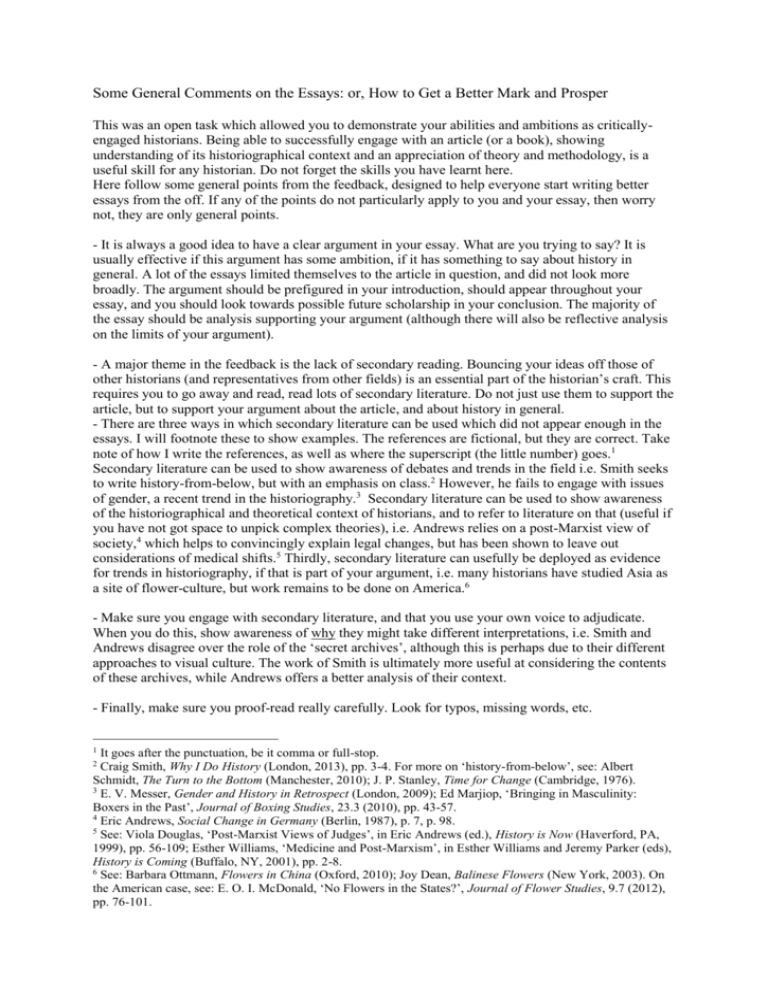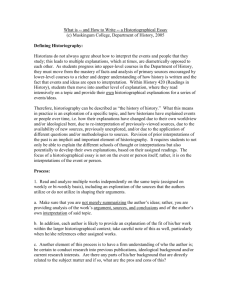Here are my general comments on the first essay
advertisement

Some General Comments on the Essays: or, How to Get a Better Mark and Prosper This was an open task which allowed you to demonstrate your abilities and ambitions as criticallyengaged historians. Being able to successfully engage with an article (or a book), showing understanding of its historiographical context and an appreciation of theory and methodology, is a useful skill for any historian. Do not forget the skills you have learnt here. Here follow some general points from the feedback, designed to help everyone start writing better essays from the off. If any of the points do not particularly apply to you and your essay, then worry not, they are only general points. - It is always a good idea to have a clear argument in your essay. What are you trying to say? It is usually effective if this argument has some ambition, if it has something to say about history in general. A lot of the essays limited themselves to the article in question, and did not look more broadly. The argument should be prefigured in your introduction, should appear throughout your essay, and you should look towards possible future scholarship in your conclusion. The majority of the essay should be analysis supporting your argument (although there will also be reflective analysis on the limits of your argument). - A major theme in the feedback is the lack of secondary reading. Bouncing your ideas off those of other historians (and representatives from other fields) is an essential part of the historian’s craft. This requires you to go away and read, read lots of secondary literature. Do not just use them to support the article, but to support your argument about the article, and about history in general. - There are three ways in which secondary literature can be used which did not appear enough in the essays. I will footnote these to show examples. The references are fictional, but they are correct. Take note of how I write the references, as well as where the superscript (the little number) goes.1 Secondary literature can be used to show awareness of debates and trends in the field i.e. Smith seeks to write history-from-below, but with an emphasis on class.2 However, he fails to engage with issues of gender, a recent trend in the historiography.3 Secondary literature can be used to show awareness of the historiographical and theoretical context of historians, and to refer to literature on that (useful if you have not got space to unpick complex theories), i.e. Andrews relies on a post-Marxist view of society,4 which helps to convincingly explain legal changes, but has been shown to leave out considerations of medical shifts.5 Thirdly, secondary literature can usefully be deployed as evidence for trends in historiography, if that is part of your argument, i.e. many historians have studied Asia as a site of flower-culture, but work remains to be done on America.6 - Make sure you engage with secondary literature, and that you use your own voice to adjudicate. When you do this, show awareness of why they might take different interpretations, i.e. Smith and Andrews disagree over the role of the ‘secret archives’, although this is perhaps due to their different approaches to visual culture. The work of Smith is ultimately more useful at considering the contents of these archives, while Andrews offers a better analysis of their context. - Finally, make sure you proof-read really carefully. Look for typos, missing words, etc. 1 It goes after the punctuation, be it comma or full-stop. Craig Smith, Why I Do History (London, 2013), pp. 3-4. For more on ‘history-from-below’, see: Albert Schmidt, The Turn to the Bottom (Manchester, 2010); J. P. Stanley, Time for Change (Cambridge, 1976). 3 E. V. Messer, Gender and History in Retrospect (London, 2009); Ed Marjiop, ‘Bringing in Masculinity: Boxers in the Past’, Journal of Boxing Studies, 23.3 (2010), pp. 43-57. 4 Eric Andrews, Social Change in Germany (Berlin, 1987), p. 7, p. 98. 5 See: Viola Douglas, ‘Post-Marxist Views of Judges’, in Eric Andrews (ed.), History is Now (Haverford, PA, 1999), pp. 56-109; Esther Williams, ‘Medicine and Post-Marxism’, in Esther Williams and Jeremy Parker (eds), History is Coming (Buffalo, NY, 2001), pp. 2-8. 6 See: Barbara Ottmann, Flowers in China (Oxford, 2010); Joy Dean, Balinese Flowers (New York, 2003). On the American case, see: E. O. I. McDonald, ‘No Flowers in the States?’, Journal of Flower Studies, 9.7 (2012), pp. 76-101. 2









